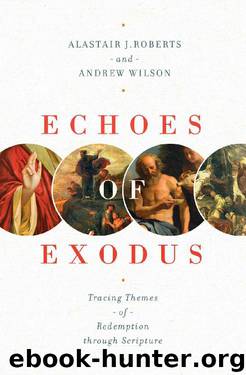Echoes of Exodus by Alastair J. Roberts & Andrew Wilson

Author:Alastair J. Roberts & Andrew Wilson [Roberts, Alastair J.]
Language: eng
Format: epub
Tags: REL023000/REL050000/REL006000
Publisher: Crossway
Published: 2018-03-14T16:00:00+00:00
14
The End of the Exodus?
1 Kings 6–13
One question we have not explored yet, but which is worth asking, is this: When did the exodus from Egypt finish? On the night of Passover? When the Israelites had crossed the Red Sea? When they received the law? At the death of Moses? After the crossing of the Jordan or the fall of Jericho? At the death of Joshua? When David became king? Never?
One answer suggests that the exodus ends much later than we usually think: “In the four hundred and eightieth year after the people of Israel came out of the land of Egypt, in the fourth year of Solomon’s reign over Israel, in the month of Ziv, which is the second month, he began to build the house of the Lord” (1 Kings 6:1).1 Three things strike us. First, the construction of Solomon’s temple is dated from the exodus. Second, it starts exactly twelve generations (480 = 12 x 40) after Israel left Egypt. Third, when we add the time taken to build the temple (seven years) and the king’s palace (thirteen years), it is exactly five hundred years from the Passover to the day Solomon blesses God for keeping his promise to Israel: “Blessed be the Lord who has given rest to his people Israel, according to all that he promised. Not one word has failed of all his good promise, which he spoke by Moses his servant” (1 Kings 8:56). The building of the temple, the dwelling place of God, somehow completes the exodus. The dream that had gripped the Israelites as they fled Egypt that night, with bowls of dough on their shoulders and anxious children in tow—the dream of being secure, prosperous, at peace, ruled by a wise king, and with a permanent house in which God’s glory lives forever—has finally been realized.
It is hard for us to grasp the significance of the temple. Israel did not see it mainly as a structure, or even as a place to go and offer sacrifice; they saw it as the place where God came down to meet them, the meeting point of heaven and earth. That’s why first the tabernacle, and then (more spectacularly) the temple, were filled with reminders of Eden, the place where God walked with humans.2 In fact, the whole thing was built to suggest a fruitful, verdant, and well-watered garden.
A walk through the temple would reveal images of pomegranates, open flowers, palm trees, lilies, cedars, and olive wood. There were basins of water sitting on bronze stands with chariot wheels (which would have also reminded worshipers of the time they walked between walls of water, chased by chariot-riding Egyptians). There were two guarding cherubim in the inner room, images of cherubim on the walls and at the doors, and two huge bronze pillars guarding the entrance to the temple, all of which echo the cherubim set up as sentries at the entrance to the garden of Eden. The temple is even described as having a
Download
This site does not store any files on its server. We only index and link to content provided by other sites. Please contact the content providers to delete copyright contents if any and email us, we'll remove relevant links or contents immediately.
The Five People You Meet in Heaven by Mitch Albom(3475)
The Secret Power of Speaking God's Word by Joyce Meyer(2974)
Real Sex by Lauren F. Winner(2967)
Name Book, The: Over 10,000 Names--Their Meanings, Origins, and Spiritual Significance by Astoria Dorothy(2939)
The Holy Spirit by Billy Graham(2892)
0041152001443424520 .pdf by Unknown(2784)
ESV Study Bible by Crossway(2732)
How The Mind Works by Steven Pinker(2729)
Ancient Worlds by Michael Scott(2625)
Churchill by Paul Johnson(2506)
The Meaning of the Library by unknow(2505)
The ESV Study Bible by Crossway Bibles(2502)
The Gnostic Gospels by Pagels Elaine(2472)
MOSES THE EGYPTIAN by Jan Assmann(2373)
Jesus by Paul Johnson(2310)
City of Stairs by Robert Jackson Bennett(2309)
The Complete Dead Sea Scrolls in English (7th Edition) (Penguin Classics) by Geza Vermes(2235)
Ancient Near Eastern Thought and the Old Testament by John H. Walton(2196)
The Nativity by Geza Vermes(2180)
